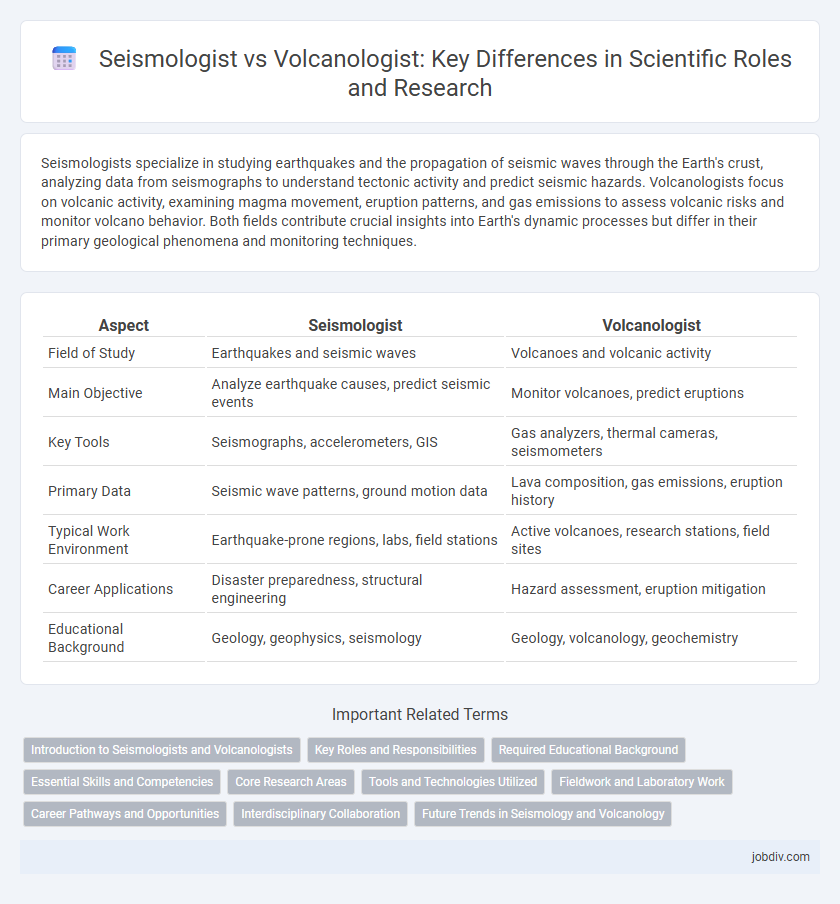Seismologists specialize in studying earthquakes and the propagation of seismic waves through the Earth's crust, analyzing data from seismographs to understand tectonic activity and predict seismic hazards. Volcanologists focus on volcanic activity, examining magma movement, eruption patterns, and gas emissions to assess volcanic risks and monitor volcano behavior. Both fields contribute crucial insights into Earth's dynamic processes but differ in their primary geological phenomena and monitoring techniques.
Table of Comparison
| Aspect | Seismologist | Volcanologist |
|---|---|---|
| Field of Study | Earthquakes and seismic waves | Volcanoes and volcanic activity |
| Main Objective | Analyze earthquake causes, predict seismic events | Monitor volcanoes, predict eruptions |
| Key Tools | Seismographs, accelerometers, GIS | Gas analyzers, thermal cameras, seismometers |
| Primary Data | Seismic wave patterns, ground motion data | Lava composition, gas emissions, eruption history |
| Typical Work Environment | Earthquake-prone regions, labs, field stations | Active volcanoes, research stations, field sites |
| Career Applications | Disaster preparedness, structural engineering | Hazard assessment, eruption mitigation |
| Educational Background | Geology, geophysics, seismology | Geology, volcanology, geochemistry |
Introduction to Seismologists and Volcanologists
Seismologists specialize in the study of earthquakes and the propagation of seismic waves through the Earth, utilizing seismographs and geophysical data to analyze fault lines and tectonic activity. Volcanologists focus on volcanic processes, monitoring magma movements, gas emissions, and eruption patterns to predict volcanic hazards and assess volcanic risk. Both disciplines employ geophysical techniques but concentrate on different Earth dynamics essential for understanding and mitigating natural disasters.
Key Roles and Responsibilities
Seismologists specialize in studying earthquakes by analyzing seismic waves to understand fault lines, predict seismic activity, and assess earthquake hazards. Volcanologists focus on monitoring volcanic eruptions, examining magma behavior, and evaluating volcanic hazards to mitigate risks for surrounding communities. Both experts utilize geological data and remote sensing technology, but their primary responsibilities center on different natural phenomena with unique predictive models.
Required Educational Background
Seismologists typically require a strong foundation in geophysics or earth sciences, often holding advanced degrees such as a Master's or Ph.D. in seismology, geology, or related fields. Volcanologists, on the other hand, pursue specialized education in volcanology, geology, or geochemistry, frequently obtaining graduate degrees focused on volcanic processes and magma dynamics. Both disciplines emphasize rigorous training in data analysis, fieldwork, and advanced modeling techniques relevant to their specific natural phenomena.
Essential Skills and Competencies
Seismologists require expertise in geophysics, data analysis, and seismic instrumentation to detect and interpret earthquake activity accurately. Volcanologists must possess strong skills in geology, remote sensing, and hazard assessment to monitor volcanic eruptions and predict potential risks. Both fields demand proficiency in mathematical modeling and fieldwork, but seismologists prioritize seismic wave analysis while volcanologists emphasize volcanic processes and magma dynamics.
Core Research Areas
Seismologists primarily study the propagation of seismic waves and the mechanics of earthquakes to understand Earth's internal structure and tectonic activity. Volcanologists focus on volcanic processes, magma dynamics, eruption prediction, and the monitoring of active volcanoes to assess volcanic hazards. Both disciplines utilize geophysical data and remote sensing technologies, but seismology emphasizes earthquake fault mechanics while volcanology concentrates on magma behavior and volcanic gas emissions.
Tools and Technologies Utilized
Seismologists utilize seismographs, accelerometers, and GPS networks to monitor and analyze earthquake activity and ground vibrations, enabling precise detection of seismic events and tectonic movements. Volcanologists employ remote sensing technologies, gas analyzers, thermal cameras, and drones to study volcanic eruptions, gas emissions, and magma dynamics for hazard assessment. Both fields integrate advanced data modeling software and satellite imagery to improve real-time monitoring and predictive capabilities in geophysical research.
Fieldwork and Laboratory Work
Seismologists conduct fieldwork by deploying seismic sensors and monitoring earthquake activity to analyze tectonic movements, while their laboratory work involves interpreting seismic data and modeling earth vibrations. Volcanologists perform field investigations by sampling volcanic rocks, gases, and monitoring active volcanoes using remote sensing technologies, with lab analysis focusing on geochemical testing and eruption pattern simulations. Both disciplines rely heavily on integrating field observations with laboratory data to understand and predict earth processes accurately.
Career Pathways and Opportunities
Seismologists specialize in studying earthquake activity and the Earth's internal vibrations, often working with geological surveys, research institutions, and government agencies focused on disaster mitigation and seismic hazard assessment. Volcanologists investigate volcanic processes, monitoring eruptions and studying magma dynamics, with career opportunities in volcanology research centers, environmental agencies, and emergency management organizations. Both fields require strong backgrounds in geology and geophysics, but seismology offers broader roles in earthquake engineering and tectonics, while volcanology emphasizes volcanism, hazard prediction, and environmental impact analysis.
Interdisciplinary Collaboration
Seismologists and volcanologists collaborate by integrating seismic data and volcanic activity monitoring to enhance eruption forecasting and hazard assessment. Combining expertise in earth sciences, they use advanced geophysical tools to analyze magma movement and fault stress interactions, leading to improved prediction models. This interdisciplinary approach amplifies the accuracy and timeliness of warnings, ultimately safeguarding communities near tectonic and volcanic zones.
Future Trends in Seismology and Volcanology
Emerging technologies in seismology and volcanology are enhancing real-time data acquisition and predictive modeling through the integration of AI and machine learning algorithms. Advancements in remote sensing, such as satellite-based interferometry and drone surveillance, enable more precise monitoring of tectonic movements and volcanic activity, improving early-warning systems. Collaborative global networks and big data analytics are driving a new era of interdisciplinary research, facilitating better hazard assessment and risk mitigation strategies.
Seismologist vs Volcanologist Infographic

 jobdiv.com
jobdiv.com